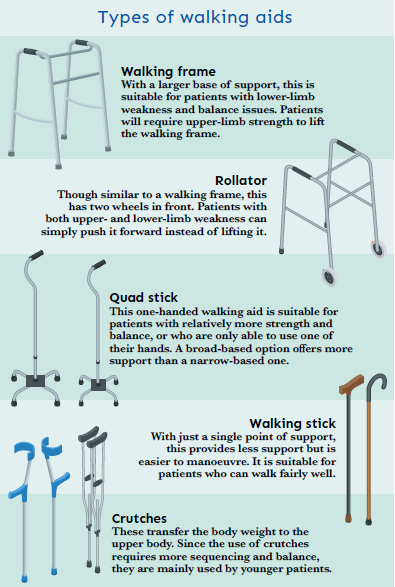Many elderly suffer
from lower limb
weakness, injury,
as well as difficulty
in balancing, and these may
affect their mobility. For such
patients, walking aids can make
an important difference in
enhancing mobility and helping
them retain their independence.
At Sengkang Community
Hospital (SKCH), which is managed
under SingHealth Community
Hospitals (SCH), approximately 70
per cent of the patients who are
aged 60 and above use some form
of walking aid, said Ms Chitra
Chandran, Senior Physiotherapist,
SKCH. Hip fractures and elective
knee replacements are two of the
common reasons why.
Seniors, however, are not the
only ones who require walking
aids. Children and young adults
with ankle sprains and lower limb
fractures may need them, too.
“Walking aids provide
additional support through the
hands and help with balance,”
said Ms Chandran. When used
properly, walking aids can reduce
the risk of falls.

Professional help
The lack of balance while walking
and completing daily tasks may be
a telltale sign that patients require
walking aids. In such cases, they
should consult medical professionals
for advice rather than simply
buying one off the shelf.
“Elderly persons in fairly good
health should have sufficient
strength to move around unaided,
even if they require more rest.
But if they find themselves
getting weaker, there could be an
underlying medical condition,”
said Ms Chandran.
“For example, a stroke may
result in sudden single-sided
weakness, and a decrease in blood
pressure may cause dizziness.
A medical professional will
do a thorough assessment to
find out the root cause before recommending a suitable walking
aid based on the patient’s
requirements,” she added.
With the wide variety of walking
aids available, physiotherapists
will recommend the most suitable
option to meet each patient’s
needs. For instance, rollators
(rolling walkers) and walking
frames may be chunkier, but they
provide more support than quad
sticks, walking sticks, and crutches.
The physiotherapist will also
adjust the walking aid to suit the
patient’s height. “If the walking
aid is too high, the user may hike
his shoulder, which can cause
shoulder strain. If it is too low,
the need to bend his body
forward may result in back pain,”
Ms Chandran explained.
Safety techniques
Physiotherapists also provide
guidance on safe use. For
instance, on level ground, patients
should first move the walking aid
forward, and step ahead with
their weaker leg, followed by the
stronger leg to ensure there is
sufficient support.
The same applies when
going down the stairs. The
weaker leg should be lowered
first so that the stronger leg
can support the weight of the
body going down. However, the
sequence changes for climbing
stairs — users must put their
stronger leg forward first so that
they have enough strength to
propel themselves upward.
When climbing stairs with a
broad-based quad stick, the entire
base of the quad stick must fit
onto the step to ensure there is
adequate support when users lean
forward. For adults with a smaller
build, when they cross a kerb with
a walking frame, they should put
the frame halfway across, move
closer, then put the frame over the
entire kerb before crossing over.
If they try to put the entire frame
across immediately, they may end
up losing their balance.
Training sessions are useful
for physiotherapists to assess
patients’ ability to coordinate
movement with a walking aid.
“For patients with cognitive
impairment or learning
disabilities, walking aids may
increase their risk of falling
and are not recommended,”
Ms Chandran said.
